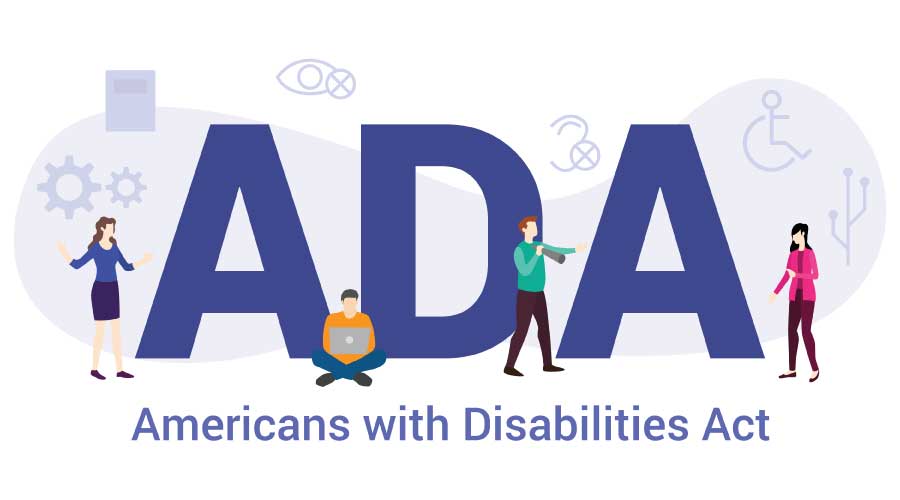Practical ADA Tactics
ADA compliance doesn't need to be complex. Consider these steps to ensure facilities access for all
By Barbara Thorpe and Michael Boga
The recent publication of new facilities access guidelines under the Americans with Disabilities Act (ADA) raises new questions for maintenance and engineering managers. At the same time, it serves as a reminder for managers and their staffs that access issues remain in many facilities.
In many cases, the remedies for these access barriers might seem complex, given the systems, equipment and materials that often are involved in renovations and remodeling. But tactics for improving access need not be complicated. In fact, in some cases the remedies are surprisingly straightforward and practical.
A closer look at the updated guidelines, along with key areas of facilities that traditionally present access challenges, is likely to reveal to managers some remedies that are not costly in terms of either time or money.
New Guidance
Managers most likely have more than a few questions about the status of the updated guidelines. What are the major changes affecting particular institutional and commercial facilities? Are the new guidelines final? If not, what is the next step?
Trying to stay on top of and understand these new accessibility guidelines can be challenging and confusing. But doing so is crucial to ensure facilities comply and become more accessible for people with disabilities, as well as more comfortable for all occupants and visitors.
The new ADA accessibility guidelines (ADAAG) were developed to implement the ADA and the Architectural Barrier Act. The guidelines update the current access requirements for public and private sectors.
After a lengthy and comprehensive process, the guidelines are closer to becoming final standards. The new guidelines now must go through a three-step process by the U.S. Department of Justice (DOJ) to be final and enforceable. The good news is that the regulatory process will allow public input on a variety of questions that will affect both the content and timing of the guidelines.
Revisions of the new guidelines will result in a number of important changes affecting educational, medical, government and commercial facilities that managers should be aware of.
The new guidelines serve as a framework or baseline for standards that will be developed by other federal agencies, including the DOJ and the U.S. Department of Transportation. It is these standards, not the Access Board’s guidelines, that the public will have to follow.
While the updated guidelines provide new guidance for enhancing facilities access, managers have very workable options for enhancing access in key areas of facilities. Restrooms are among the most challenging of these areas, so managers might consider these adaptations to key restroom components to improve access.
Signage
Even before building occupants get to the restroom, access codes require that directional signage indicate the shortest route. Directional signage gives visitors assistance and information about the location of restrooms. But they are especially important for persons with disabilities. Compared to permanent signage, directional signage does not require Braille and raised lettering. It must, however, be located at the proper height for viewing.
One practical compliance tactic is to have workers install accessible latch-side signage at the entrance to the restroom. Workers should center the latch-side signage at 60 inches on center above the finished floor. All plans should specify that compliant, permanent, latch-side signage contains raised letters and characters, Braille and the international symbol of accessibility.
Federal requirements specify only latch-side signage, but some state codes require additional signage. For example, the state of California requires that doors to restrooms also feature gender symbols, namely, a triangle-shaped sign for men, a circular sign for women, and a circle on a triangle for unisex restrooms.
Door Hardware
A general test for accessible door hardware is determining the required type of grasp. If a door hardware component requires that users apply tight pinching or grasping, or if a user cannot operate the hardware with a closed fist, the component probably is not considered accessible.
Handles that are not considered accessible for doors include a round, single-knob door handle and thumb-latch or finger-pull doorknobs that provide less than 11/2 inches of clearance. Among the types of accessible door handles are a lever-type or push-pull handle.
Managers should be careful not to specify single-knob, twist-type handles for installation in lavatories. In many cases, users can not operate them with a closed fist. Instead, managers should consider installing automatic openers.
Finally, the door hardware on toilet stalls also must be accessible. A paddle-type latch mechanism that requires no tight pinching or grasping often works best. Workers must install the inside handle immediately below the lock mechanism.
Doors
Installers should adjust door pressure to 8.5 pounds for exterior pressure and no more than 5 pounds for interior restroom doors. The minimum door width is 32 inches.
The maximum allowable change in elevation at a door threshold is a .25-inch vertical rise or a beveled .5 inch. Threshold ramps that are made of recycled rubber tires can help facilities achieve a compliant threshold transition.
Also, the door’s swing should not encroach into a clear floor space unless state codes allow such movement. Both the restroom and the accessible stall must have a 60-inch turning radius. Many restrooms only need a simple reversal of the door swing in order to achieve compliance.
Water Closets
Accessible toilet centerlines must be 18 inches from the nearest side wall. One solution managers can turn to to meet this requirement is to install a knee wall or an offset toilet mount, which provides the exact center line measurement.
Installers also should locate flush valves on the wide side of the space. Another way to solve the problem of the location of the flush control is to add an automatic flush valve.
Also, toilet seat heights should be 17-19 inches above the finished floor. Managers should avoid specifying toilet seat spacers, which are designed to provide elevation to the required height. Under current ADA standards, men’s toilet rooms with six or more water closets and urinals but fewer than six toilet compartments are not required to provide an ambulatory accessible toilet compartment with grab bars.
Under the new ADAAG 213.1, urinals will be counted. If there are a total of six urinals or water closets, the updated ADAAG will require an ambulatory accessible toilet compartment with grab bars.
Dispensers
Technicians should be careful not install paper and soap dispensers or hand dryers more than 40 inches above the finished floor for adult standards. Managers need to remember that the 40-inch maximum height requirement refers to the operating mechanism or feature. It does not refer to the bottom of the dispenser. Some paper-towel dispensers have an operating mechanism or handle that is higher than the bottom of the dispenser.
One way to provide accessibility to dispensers is to specify a unit with automatic controls, such as infrared or motion-sensor-type activation switches. But be careful: The height at which the dispenser is activated by the automatic control can not be more than 40 inches high.
Toilet-paper dispensers that are installed in the wrong location run the risk of interfering with visitors’ access to grab bars. This conflict makes the dispensers non-compliant. Technicians can install the paper dispensers recessed so that they are flush behind the side grab bar.
Dispensers for sanitary seat cover need also require clear floor space. Technicians should be careful not to install these dispensers above the back of a water closet. Dispensers located here will not be compliant because of the lack of required floor space in front of them.
Manufacturers are responding to these facilities access challenges. One product on the market combines a toilet-paper dispenser and a seat-cover dispenser in one flush-mount unit that fits behind the side grab bar. As a result of this design, the unit does not interfere with the bar’s use.
Communicate for Success
Facilities, operations, and building occupants change regularly. As a result of these shifts, managers need to communicate as thoroughly as possible about their departments’ efforts to comply with facility access guidelines.
One crucial step in the regard is to designate an ADA coordinator. Section 35.107 of ADA requires that an organizations designate one responsible employee, but large public entities might have more than one ADA coordinator.
Managers should post the ADA coordinator’s name, title, address, phone number, TDD/TTY number, and e-mail in a visible public location, and they should include this information in handbooks and all other organizationwide publications.
Managers also should post ADA-related notices in selected locations and on the organization’s web site. They should pay special attention to provide additional information to front-line staff in non-public and outlying areas.
Managers also can use these tactics to communicate their compliance efforts:
-
Develop a brochure or an informational packet that provides information on ADA requirements, as well as information on how to contact the organization’s ADA coordinator.
-
Develop a procedure for providing materials in accessible alternate formats. These alternate formats might include large print, taped materials or Braille. All of these materials need not be available in an alternate format prior to a request. But a procedure should be in place to provide an alternate format in a timely manner if one is requested.
-
Review web sites for accessibility. For little or no charge, services such as Bobby Worldwide will evaluate web sites in order to ensure their accessibility.
-
Provide accommodation statements on all public notices. Such statements should provide a contact in the event an individual with a disability needs accommodation to participate in a program, service or activity.
-
Give members of the public, individuals with disabilities, and organizations representing individuals with disabilities an opportunity to provide input. Tools for this purpose include postings, surveys of facility users, organizations and site administrators, and newspaper notices.
-
Use appropriate terminology on all verbal and printed communication. For example, use the term “disabled” instead of “handicapped.” Refer to individuals with disabilities as people first, so instead of saying “hearing-impaired person,” say “person with a hearing impairment.”
For suggestions on soliciting occupant feedback when developing an effective ADA compliance plan, see sidebar below.
Barbara Thorpe is president and Michael Boga is vice president of Disability Access Consultants Inc. (DAC) — (800) 743-7067 — a national accessibility consulting firm. DAC assists public entities and businesses with compliance with ADA and related legislation by developing self-evaluations, transition/barrier removal plans, training, consultation, and accessibility-management software.
Tactic for Success: Get Occupant Input
Involving building occupants and visitors in the planning process will result in a plan that more thoroughly addresses the access needs of all involved. Among the steps to consider are these:
-
Make the self-evaluation and transition plan available for public inspection.
-
Post a policy or statement of nondiscrimination that includes members of the public and employees.
-
Develop an ADA-advisory committee that includes individuals with disabilities and other members of the public.
-
Maintain a library of staff development resources that can be checked out or made available, including videotapes, presentations and audio tapes.
-
Provide ADA materials and staff development sessions for administrators, supervisors, facilities managers, maintenance and operations staffs, and other departments as appropriate.
-
Adopt or develop grievance- or uniform-compliance procedures that includes members of the public, recipients of services and employees.
-
Disseminate and post information regarding the compliance procedures.
— Barbara Thorpe and Michael Boga
|
Related Topics:









